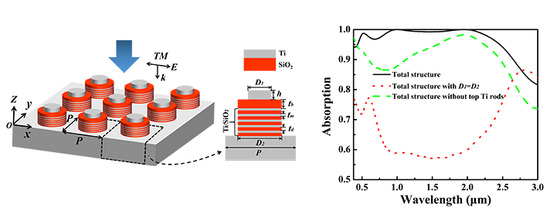Cascaded Nanorod Arrays for Ultrabroadband, Omnidirectional and Polarization-Insensitive Absorption
Abstract
1. Introduction
2. Structure and Design
3. Absorption Performance Analysis
4. Results and Discussions
5. Conclusions
Author Contributions
Funding
Conflicts of Interest
References
- Yong, Z.D.; Zhang, S.L.; Gong, C.S.; He, S.L. Narrow band perfect absorber for maximum localized magnetic and electric field enhancement and sensing applications. Sci. Rep. 2016, 6, 24063. [Google Scholar] [CrossRef] [PubMed]
- Meng, L.J.; Zhao, D.; Ruan, Z.C.; Li, Q.; Yang, Y.Q.; Qiu, M. Optimized grating as an ultra-narrow band absorber or plasmonic sensor. Opt. Lett. 2014, 39, 1137. [Google Scholar] [CrossRef] [PubMed]
- Yang, Z.Q.; Du, K.; Lu, F.F.; Pang, Y.; Hua, S.J.; Gan, X.T.; Zhang, W.D.; Chua, S.J.; Mei, T. Silica nanocone array as a template for fabricating a plasmon induced hot electron photodetector. Photonics Res. 2019, 7, 294–299. [Google Scholar] [CrossRef]
- Gong, Y.k.; Wang, Z.B.; Li, K.; Uggalla, L.; Huang, J.G.; Copner, N.; Zhou, Y.; Qiao, D.; Zhu, J.Y. Highly efficient and broadband mid-infrared metamaterial thermal emitter for optical gas sensing. Opt. Lett. 2017, 42, 4537–4540. [Google Scholar] [CrossRef]
- Mason, J.A.; Smith, S.; Wasserman, D. Strong absorption and selective thermal emission from a midinfrared metamaterial. Appl. Phys. Lett. 2011, 98, 241105. [Google Scholar] [CrossRef]
- Vora, A.; Gwamuri, J.; Pala, N.; Kulkarni, A.; Pearce, J.M.; Güney, D.Ö. Exchanging ohmic losses in metamaterial absorbers with useful optical absorption for photovoltaics. Sci. Rep. 2014, 4, 4901. [Google Scholar] [CrossRef]
- Hägglund, C.; Zeltzer, G.; Ruiz, R.; Wangperawong, A.; Roelofs, K.E.; Bent, S.F. Strong coupling of plasmon and nanocavity modes for dual-band, near-perfect absorbers and ultrathin photovoltaics. ACS Photonics 2016, 3, 456–463. [Google Scholar] [CrossRef]
- Landy, N.I.; Sajuyigbe, S.; Mock, J.J.; Smith, D.R.; Padilla, W.J. Perfect metamaterial absorber. Phys. Rev. Lett. 2008, 100, 207402. [Google Scholar] [CrossRef]
- Lee, B.J.; Wang, L.P.; Zhang, Z.M. Coherent thermal emission by excitation of magnetic polaritons between periodic strips and a metallic film. Opt. Express 2008, 16, 11328–11336. [Google Scholar] [CrossRef]
- Liao, Y.L.; Zhao, Y. Absorption manipulation in a narrowband infrared absorber based on the hybridization of gap plasmon and Fabry-Perot resonance. Plasmonics 2015, 10, 1219–1223. [Google Scholar] [CrossRef]
- Hao, J.M.; Wang, J.; Liu, X.L.; Padilla, W.J.; Zhou, L.; Qiu, M. High performance optical absorber based on a plasmonic metamaterial. Appl. Phys. Lett. 2010, 96, 251104. [Google Scholar] [CrossRef]
- Hao, J.M.; Zhou, L.; Qiu, M. Nearly total absorption of light and heat generation by plasmonicmetamaterials. Phys. Rev. B 2011, 83, 165107. [Google Scholar] [CrossRef]
- Fang, Z.Y.; Zhen, Y.R.; Fan, L.R.; Zhu, X.; Nordlander, P. Tunable wide-angle plasmonic perfect absorber at visible frequencies. Phys. Rev. B 2012, 85, 245401. [Google Scholar] [CrossRef]
- Liu, N.; Mesch, M.; Weiss, T.; Hentschel, M.; Giessen, H. Infrared perfect absorber and its application as plasmonic sensor. Nano Lett. 2010, 10, 2342–2348. [Google Scholar] [CrossRef]
- Cheng, H.; Chen, S.Q.; Yang, H.F.; Li, J.J.; An, X.; Gu, C.Z.; Tian, J.G. A polarization insensitive and wide-angle dual-band nearly perfect absorber in the infrared regime. J. Opt. 2012, 14, 085102. [Google Scholar] [CrossRef]
- Wu, C.H.; Shvets, G. Design of metamaterial surfaces with broad-band absorbance. Opt. Lett. 2012, 37, 308–310. [Google Scholar] [CrossRef]
- Cui, Y.X.; Xu, J.; Fung, K.H.; Jin, Y.; Kumar, A.; He, S.L.; Fang, N.X. A thin film broadband absorber based on multi-sized nanoantennas. Appl. Phys. Lett. 2011, 99, 253101. [Google Scholar] [CrossRef]
- Hu, C.G.; Liu, L.Y.; Zhao, Z.Y.; Chen, X.N.; Luo, X.G. Mixed plasmons coupling for expanding the bandwidth of near-perfect absorption at visible frequencies. Opt. Express 2009, 17, 16745–16749. [Google Scholar] [CrossRef]
- Hendrickson, J.; Guo, J.P.; Zhang, B.Y.; Buchwald, W.; Soref, R. Wideband perfect light absorber at midwave infrared using multiplexed metal structures. Opt. Lett. 2012, 37, 371–373. [Google Scholar] [CrossRef]
- Wang, H.; Wang, L.P. Perfect selective metamaterial solar absorbers. Opt. Express 2013, 21, A1078–A1093. [Google Scholar] [CrossRef]
- Lefebvre, A.; Costantini, D.; Doyen, I.; Levesque, Q.; Lorent, E.; Jacolin, D.; Greffet, J.J.; Boutami, S.; Benisty, H. CMOS compatible metal-insulator-metal plasmonic perfect absorbers. Opt. Mater. Express 2016, 6, 2389–2396. [Google Scholar] [CrossRef]
- Cheng, C.W.; Abbas, M.N.; Chiu, C.W.; Lai, K.T.; Shih, M.H.; Chang, Y.C. Wide-angle polarization independent infrared broadband absorbers based on metallic multisized disk arrays. Opt. Express 2012, 20, 10376–10381. [Google Scholar] [CrossRef]
- Liu, Z.Q.; Liu, G.Q.; Liu, X.S.; Wang, Y.; Fu, G.L. Titanium resonators based ultra-broadband perfect light absorber. Opt. Mater. 2018, 83, 118–123. [Google Scholar] [CrossRef]
- Liu, X.L.; Tyler, T.; Starr, T.; Starr, A.F.; Jokerst, N.M.; Padilla, W.J. Taming the blackbody with metamaterials. Phys. Rev. Lett. 2011, 107, 045901. [Google Scholar] [CrossRef]
- Li, Z.G.; Stan, L.; Czaplewski, D.A.; Yang, X.D.; Gao, J. Wavelength-selective mid-infrared metamaterial absorbers with multiple tungsten cross resonators. Opt. Express 2018, 26, 5616–5631. [Google Scholar] [CrossRef]
- Ghobadi, A.; Dereshgi, S.A.; Hajian, H.; Bozok, B.; Butun, B.; Ozbay, E. Ultra-broadband, wide angle absorber utilizing metal insulator multilayers stack with a multi-thickness metal surface texture. Sci. Rep. 2017, 7, 4755. [Google Scholar] [CrossRef]
- Sang, T.; Gao, J.; Yin, X.; Qi, H.L.; Wang, L.; Jiao, H.F. Angle-insensitive broadband absorption enhancement of graphene using a multi-grooved metasurface. Nanoscale Res. Lett. 2019, 14, 105. [Google Scholar] [CrossRef]
- Poddubny, A.; Iorsh, I.; Belov, P.; Kivshar, Y. Hyperbolic metamaterials. Nat. Photonics 2013, 7, 948. [Google Scholar] [CrossRef]
- Zhukovsky, S.V.; Kidwai, O.; Sipe, J.E. Physical nature of volume plasmonpolaritons in hyperbolic metamaterials. Opt. Express 2013, 21, 14982–14987. [Google Scholar] [CrossRef]
- Shekhar, P.; Atkinson, J.; Jacob, Z. Hyperbolic metamaterials: Fundamentals and applications. Nano Converg. 2014, 1, 14. [Google Scholar] [CrossRef]
- Xiang, Y.J.; Dai, X.Y.; Guo, J.; Zhang, H.; Wen, S.C.; Tang, D.Y. Critical coupling with graphene-based hyperbolic metamaterials. Sci. Rep. 2014, 4, 5483. [Google Scholar] [CrossRef]
- Sreekanth, K.V.; Alapan, Y.; Elkabbash, M.; Ilker, E.; Hinczewski, M.; Gurkan, U.A.; Luca, A.D.; Strangi, G. Extreme sensitivity biosensing platform based on hyperbolic metamaterials. Nat. Mater. 2016, 15, 621–627. [Google Scholar] [CrossRef] [PubMed]
- Qi, H.L.; Sang, T.; Wang, L.; Yin, X.; Wang, J.C.; Wang, Y.K. Dual-band light absorption enhancement in hyperbolic rectangular array. Appl. Sci. 2019, 9, 2011. [Google Scholar] [CrossRef]
- Cao, S.; Yu, W.; Wang, T.; Xu, Z.; Wang, C.; Fu, Y.; Liu, Y. Two-dimensional subwavelength meta-nanopillar array for efficient visible light absorption. Appl. Phys. Lett. 2013, 102, 161109. [Google Scholar] [CrossRef]
- Cui, Y.X.; Fung, K.H.; Xu, J.; Ma, H.; Jin, Y.; He, S.L.; Fang, N.X. Ultrabroadband light absorption by a sawtooth anisotropic metamaterial slab. Nano Lett. 2012, 12, 1443–1447. [Google Scholar] [CrossRef]
- Hu, H.F.; Ji, D.X.; Zeng, X.; Liu, K.; Gan, Q.Q. Rainbow trapping in hyperbolic metamaterial waveguide. Sci. Rep. 2013, 3, 1249. [Google Scholar] [CrossRef]
- Ji, D.X.; Song, H.M.; Zeng, X.; Hu, H.F.; Liu, K.; Zhang, N.; Gan, Q.Q. Broadband absorption engineering of hyperbolic metafilm patterns. Sci. Rep. 2014, 4, 4498. [Google Scholar] [CrossRef]
- Zhou, J.; Kaplan, A.F.; Chen, L.; Guo, L.J. Experiment and theory of the broadband absorption by a tapered hyperbolic metamaterial array. ACS Photonics 2014, 1, 618–624. [Google Scholar] [CrossRef]
- Wu, J. Broadband light absorption by tapered metal-dielectric multilayered grating structures. Opt. Commun. 2016, 365, 93–98. [Google Scholar] [CrossRef]
- Li, Y.L.; An, B.; Li, L.Z.; Gao, J. Broadband LWIR and MWIR absorber by trapezoid multilayered grating and SiO2 hybrid structure. Opt. Quant. Electron. 2018, 50, 459. [Google Scholar] [CrossRef]
- Long, C.; Yin, S.; Wang, W.; Li, W.; Zhu, J.F.; Guan, J.G. Broadening the absorption bandwidth of metamaterial absorbers by transverse magnetic harmonics of 210 mode. Sci. Rep. 2016, 6, 21431. [Google Scholar] [CrossRef]
- Liang, Q.Q.; Wang, T.S.; Lu, Z.W.; Sun, Q.; Fu, Y.Q.; Yu, W.X. Metamaterial-based two dimensional plasmonic subwavelength structures offer the broadest waveband light harvesting. Adv. Opt. Mater. 2013, 1, 43–49. [Google Scholar] [CrossRef]
- Ding, F.; Jin, Y.; Li, B.R.; Cheng, H.; Mo, L.; He, S.L. Ultrabroadband strong light absorption based on thin multilayered metamaterials. Laser Photonics Rev. 2014, 8, 946–953. [Google Scholar] [CrossRef]
- Lin, Y.Y.; Cui, Y.X.; Ding, F.; Fung, K.H.; Ji, T.; Li, D.D.; Hao, Y.Y. Tungsten based anisotropic metamaterial as an ultra-broadband absorber. Opt. Mater. Express 2017, 7, 606–617. [Google Scholar] [CrossRef]
- Hu, S.; Yang, H.L.; Huang, X.J.; Liu, D. Metamaterial-based frustum of cones array nanostructure for efficient absorber in the solar spectral band. Appl. Phys. A 2014, 117, 1375–1380. [Google Scholar] [CrossRef]
- Hoa, N.T.Q.; Tung, P.D.; Lam, P.H.; Dung, N.D.; Quang, N.H. Numerical study of an ultrabroadband, wide-angle, polarization-insensitivity metamaterial absorber in the visible region. J. Electron. Mater. 2018, 47, 2634–2639. [Google Scholar] [CrossRef]
- Hu, S.; Yang, S.Y.; Liu, Z.; Quan, B.G.; Li, J.J.; Gu, C.Z. Broadband and polarization-insensitive absorption based on a set of multisized Fabry–Perot-like resonators. J. Phys. Chem. C 2019, 123, 13856–13862. [Google Scholar] [CrossRef]
- Yin, X.; Chen, L.; Li, X. Ultra-broadband super light absorber based on multi-sized tapered hyperbolic metamaterial waveguide arrays. J. Lightwave Technol. 2015, 33, 3704–3710. [Google Scholar] [CrossRef]
- Yin, X.; Long, C.; Li, J.H.; Zhu, H.; Chen, L.; Guan, J.G.; Li, X. Ultra-wideband microwave absorber by connecting multiple absorption bands of two different-sized hyperbolic metamaterial waveguide arrays. Sci. Rep. 2015, 5, 15367. [Google Scholar] [CrossRef]
- Tsakmakidis, K.L.; Boardman, A.D.; Hess, O. ‘Trapped rainbow’ storage of light in metamaterials. Nature 2007, 450, 397–401. [Google Scholar] [CrossRef]
- Smolyaninova, V.N.; Smolyaninov, I.I.; Kildishev, A.V.; Shalaev, V.M. Experimental observation of the trapped rainbow. Appl. Phys. Lett. 2010, 96, 211121. [Google Scholar] [CrossRef]
- Palik, E.D. Handbook of Optical Constants of Solids; Academic Press: New York, NY, USA, 1998. [Google Scholar]
- Zhou, J.Y.; Sang, T.; Li, J.L.; Wang, R.; Wang, L.; Wang, B.X.; Wang, Y.K. Modal analysis on resonant excitation of two-dimensional waveguide grating filters. Opt. Commun. 2017, 405, 350–354. [Google Scholar] [CrossRef]
- Wu, J. Absorption enhancement in thin-film solar cells based on periodically chirped structure. Sol. Energy 2018, 165, 85–89. [Google Scholar] [CrossRef]
- Deng, G.S.; Song, X.L.; Dereshgi, S.A.; Xu, H.Q.; Aydin, K. Tunable multi-wavelength absorption in mid-IR region based on a hybrid patterned graphene-hBN structure. Opt. Express 2019, 27, 23576–23584. [Google Scholar] [CrossRef]
- Hoa, N.T.Q.; Lam, P.H.; Tung, P.D.; Tuan, T.S.; Nguyen, H. Numerical study of a wide-angle and polarization-insensitive ultrabroadband metamaterial absorber in visible and near-infrared region. IEEE Photonics J. 2019, 11, 4600208. [Google Scholar] [CrossRef]
- He, X.J.; Yan, S.T.; Lu, G.J.; Zhang, Q.F.; Wu, F.M.; Jiang, J.X. An ultra-broadband polarization-independent perfect absorber for solar spectrum. RSC Adv. 2015, 5, 61955–61959. [Google Scholar] [CrossRef]
- Krenn, J.R.; Weeber, J.C.; Dereux, A.; Bourillot, E.; Goudonnet, J.P. Direct observation of localized surface plasmon coupling. Phys. Rev. B 1999, 60, 5029–5033. [Google Scholar] [CrossRef]
- Ghobadi, A.; Hajian, H.; Gokbayrak, M.; Dereshgi, S.A.; Toprak, A.; Butun, B.; Ozbay, E. Visible light nearly perfect absorber: An optimum unit cell arrangement for near absolute polarization insensitivity. Opt. Express 2017, 25, 27624–27634. [Google Scholar] [CrossRef]
- Chanda, D.; Shigeta, K.; Truong, T.; Lui, E.; Mihi, A.; Schulmerich, M.; Braun, P.V.; Bhargava, R.; Rogers, J.A. Coupling of plasmonic and optical cavity modes in quasi-three-dimensional plasmonic crystals. Nat. Commun. 2011, 2, 479. [Google Scholar] [CrossRef]
- Song, H.J.; Zang, J.X.; Fei, G.T.; Wang, J.F.; Jiang, K.; Wang, P.; Lu, Y.H.; Iorsh, I.; Xu, W.; Jia, J.H.; et al. Near-field coupling and resonant cavity modes in plasmonicnanorodmetamaterials. Nanotechnology 2016, 27, 415708. [Google Scholar] [CrossRef]
- Wang, J.F.; Zhang, C.; Zhang, J.X.; Song, H.J.; Wang, P.; Lu, Y.H.; Fei, G.T.; Xu, W.; Xu, W.; Zhang, L.D.; et al. Hybrid plasmonic cavity modes in arrays of gold nanotubes. Adv. Opt. Mater. 2017, 5, 1600731. [Google Scholar] [CrossRef]
- Smith, D.R.; Vier, D.C.; Koschny, T.; Soukoulis, C.M. Electromagnetic parameter retrieval from inhomogeneous metamaterials. Phys. Rev. E 2005, 71, 036617. [Google Scholar] [CrossRef]
- Yin, X.; Sang, T.; Qi, H.L.; Li, G.Q.; Wang, X.; Wang, J.C.; Wang, Y.K. Symmetry-broken square silicon patches for ultra-narrowband light absorption. Sci. Rep. 2019, 9, 17477. [Google Scholar] [CrossRef]
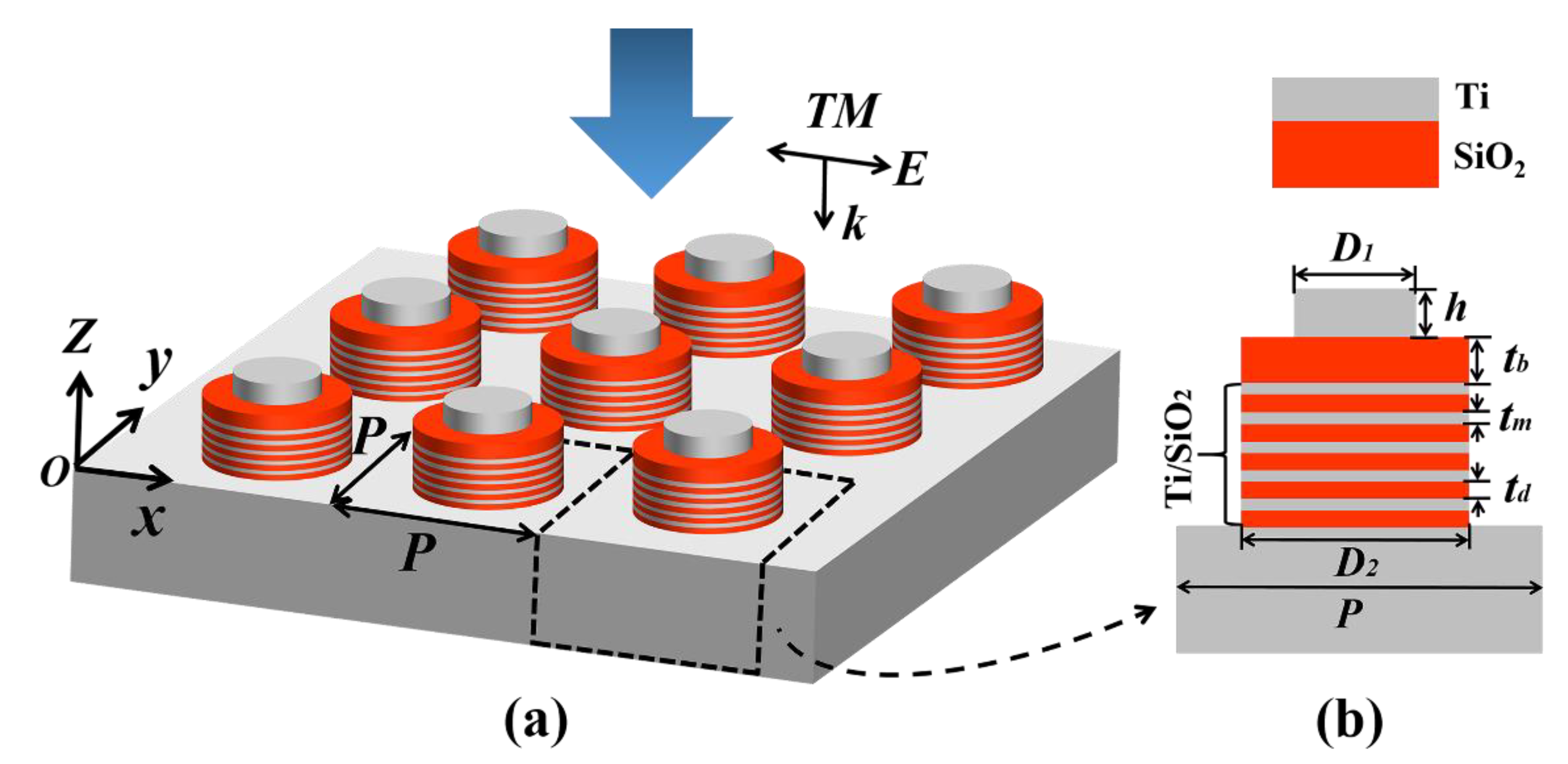
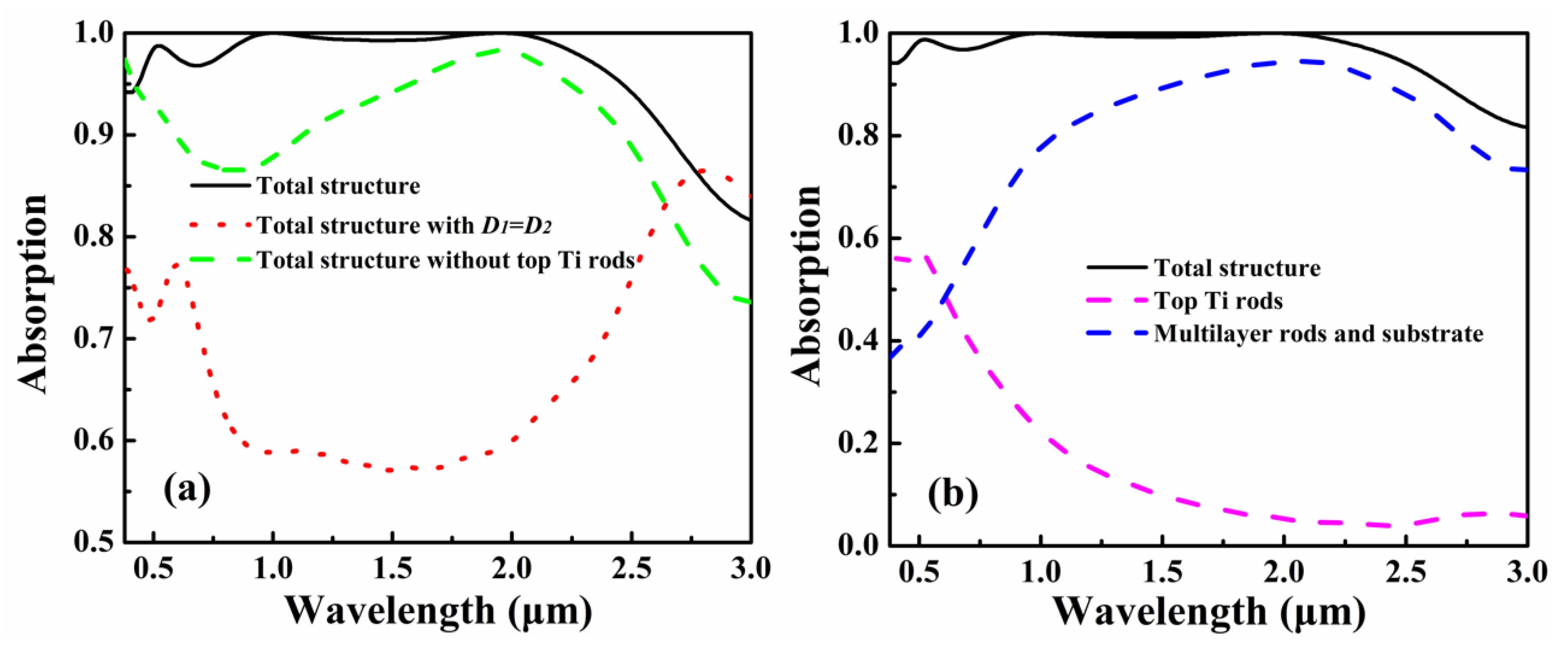

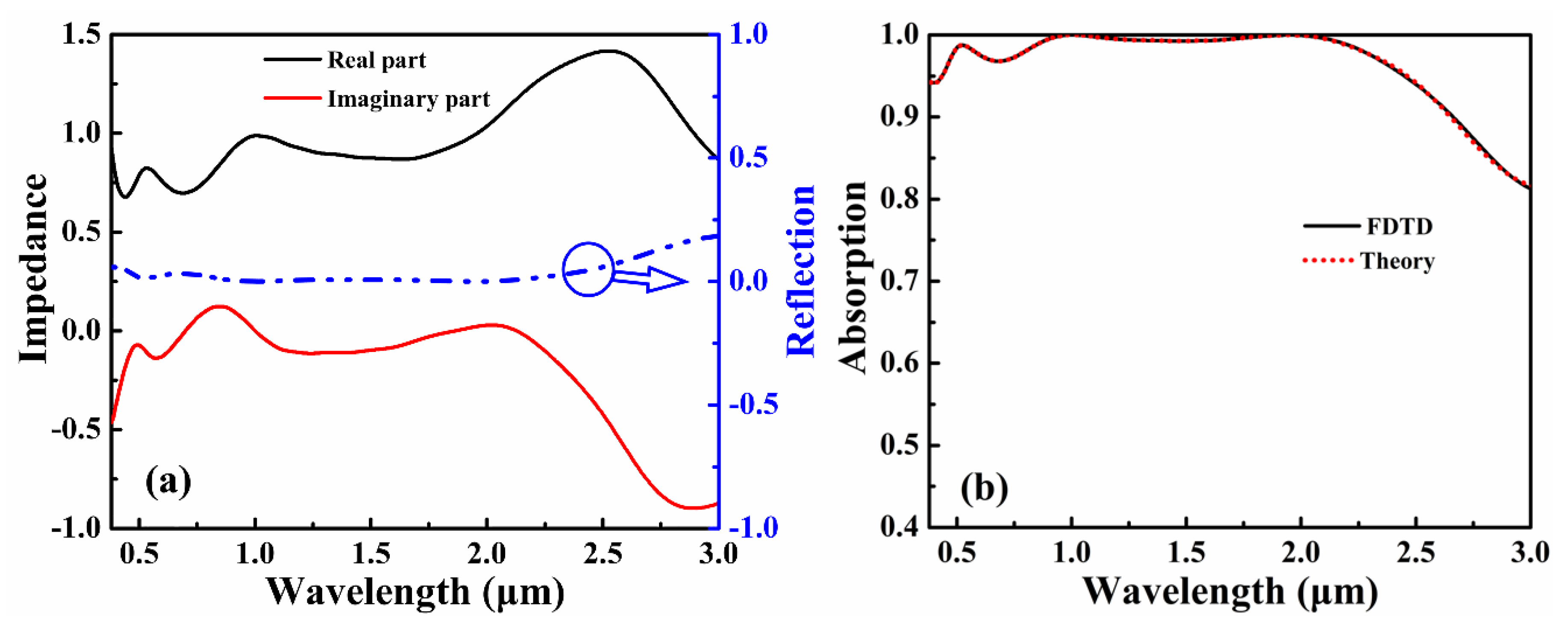
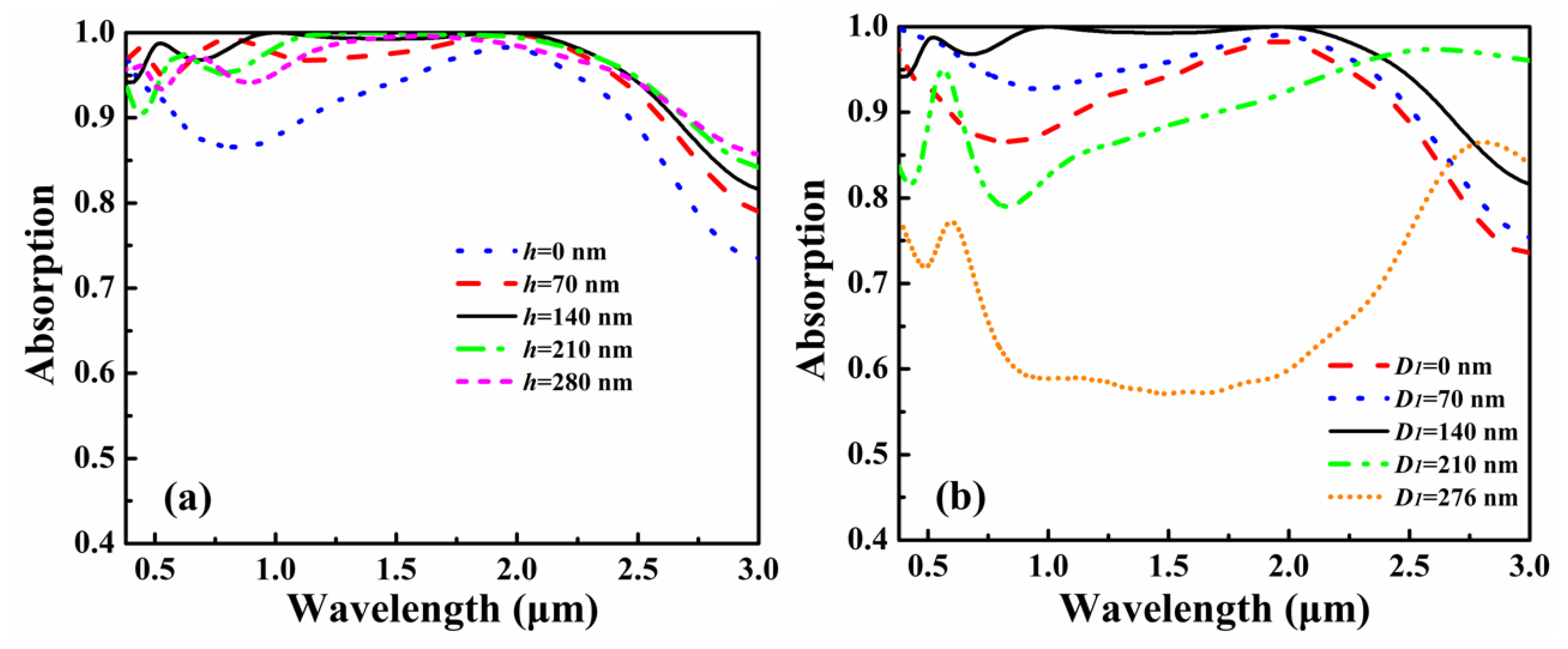
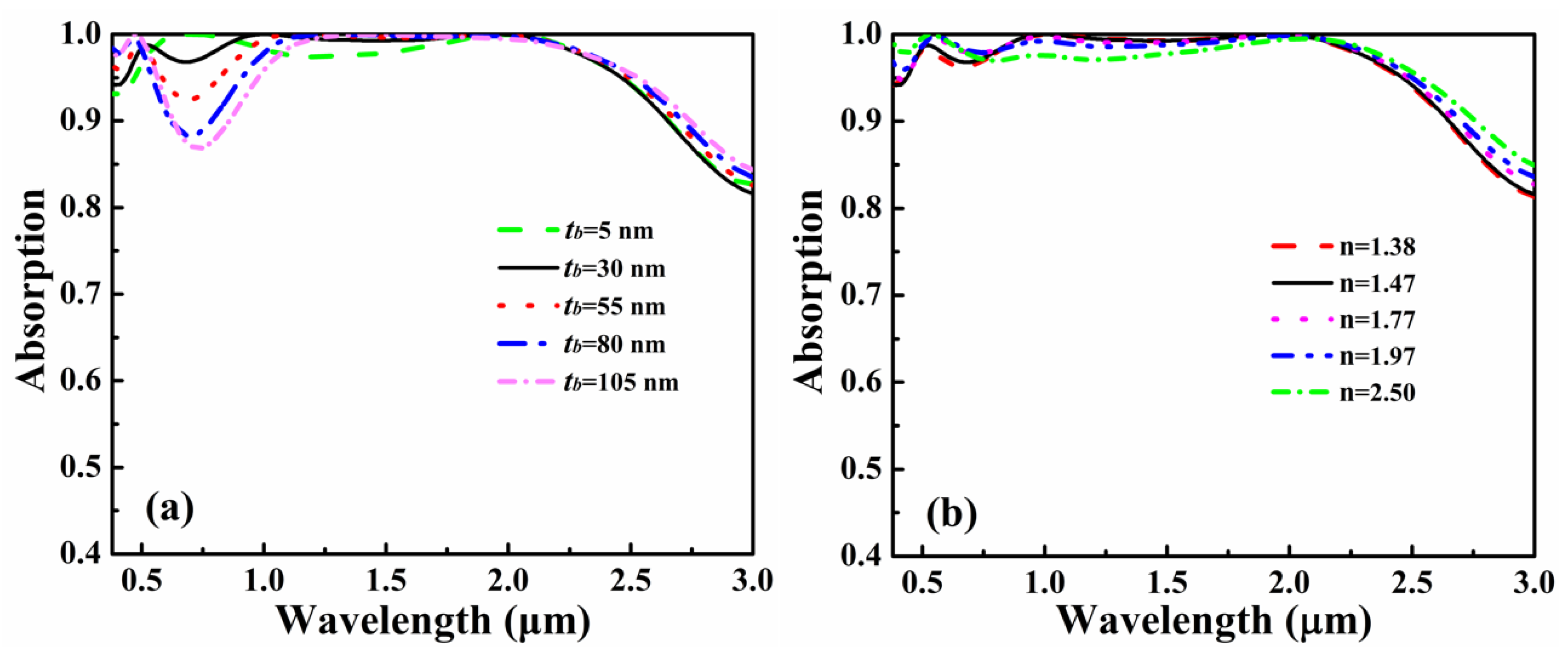
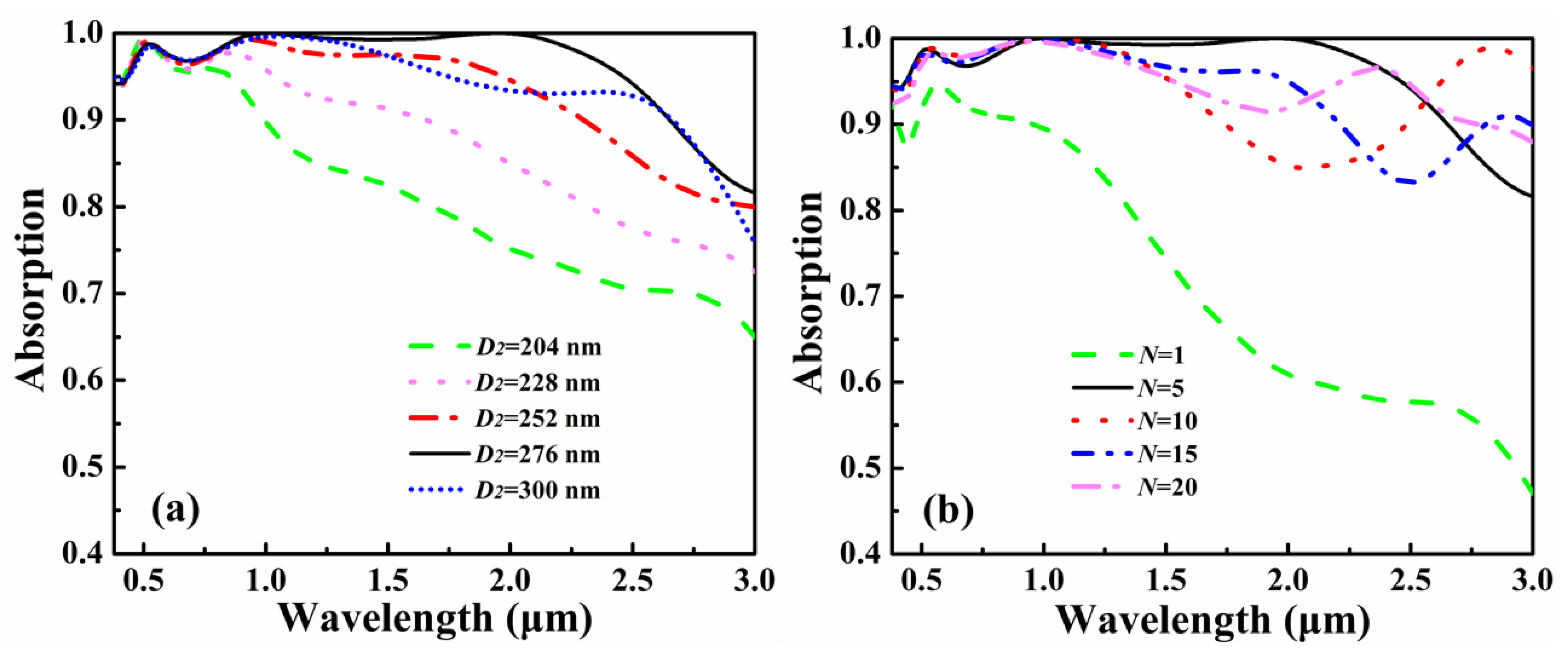

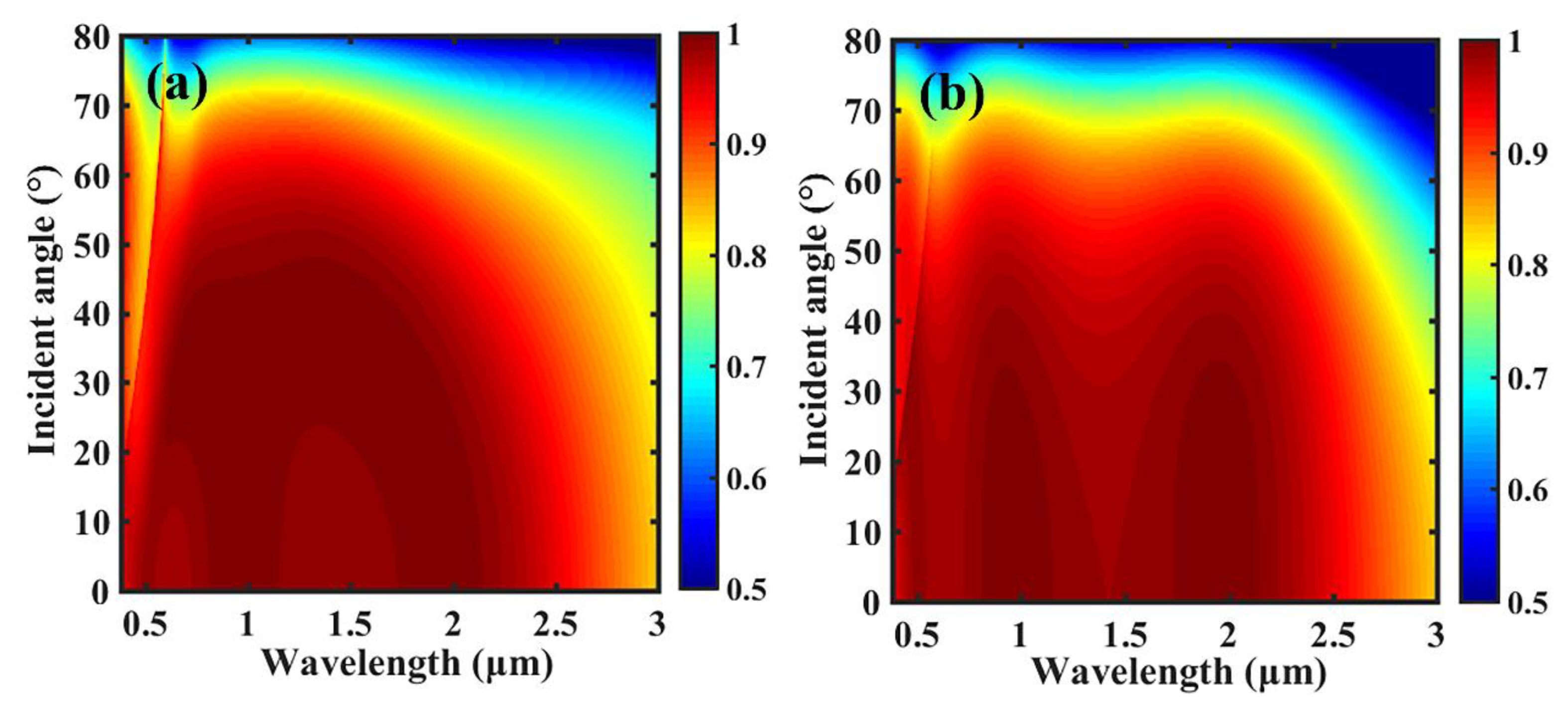
© 2020 by the authors. Licensee MDPI, Basel, Switzerland. This article is an open access article distributed under the terms and conditions of the Creative Commons Attribution (CC BY) license (http://creativecommons.org/licenses/by/4.0/).
Share and Cite
Wang, X.; Sang, T.; Qi, H.; Li, G.; Yin, X.; Wang, Y. Cascaded Nanorod Arrays for Ultrabroadband, Omnidirectional and Polarization-Insensitive Absorption. Appl. Sci. 2020, 10, 3878. https://doi.org/10.3390/app10113878
Wang X, Sang T, Qi H, Li G, Yin X, Wang Y. Cascaded Nanorod Arrays for Ultrabroadband, Omnidirectional and Polarization-Insensitive Absorption. Applied Sciences. 2020; 10(11):3878. https://doi.org/10.3390/app10113878
Chicago/Turabian StyleWang, Xun, Tian Sang, Honglong Qi, Guoqing Li, Xin Yin, and Yueke Wang. 2020. "Cascaded Nanorod Arrays for Ultrabroadband, Omnidirectional and Polarization-Insensitive Absorption" Applied Sciences 10, no. 11: 3878. https://doi.org/10.3390/app10113878
APA StyleWang, X., Sang, T., Qi, H., Li, G., Yin, X., & Wang, Y. (2020). Cascaded Nanorod Arrays for Ultrabroadband, Omnidirectional and Polarization-Insensitive Absorption. Applied Sciences, 10(11), 3878. https://doi.org/10.3390/app10113878




